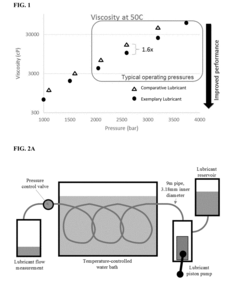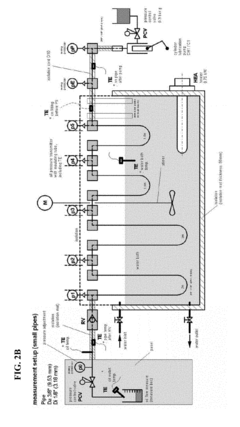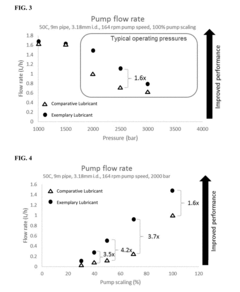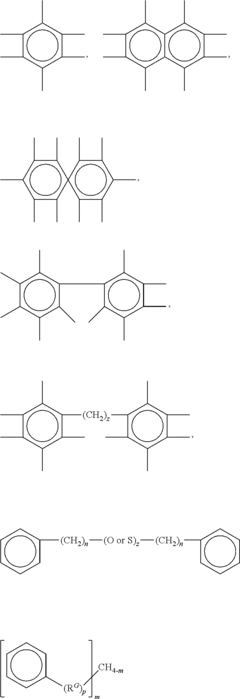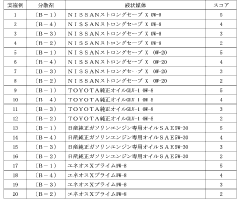Lubrication efficiency in high-pressure environments with MSH.
JUL 17, 20259 MIN READ
Generate Your Research Report Instantly with AI Agent
Patsnap Eureka helps you evaluate technical feasibility & market potential.
MSH Lubrication Background and Objectives
Molybdenum disulfide (MoS2) has long been recognized as an effective solid lubricant, particularly in high-pressure environments. The layered structure of MoS2 allows for easy shearing between atomic planes, providing excellent lubrication properties. However, traditional MoS2 lubricants have limitations in terms of durability and performance under extreme conditions.
In recent years, the development of MoS2 hybrid (MSH) materials has emerged as a promising solution to enhance lubrication efficiency in high-pressure environments. MSH combines the inherent lubricating properties of MoS2 with other materials or structures to create synergistic effects, improving overall performance and addressing the limitations of conventional MoS2 lubricants.
The evolution of MSH technology has been driven by the increasing demands of various industries, including aerospace, automotive, and manufacturing, where high-pressure conditions are common. These sectors require lubricants that can maintain their effectiveness under extreme loads, temperatures, and pressures, while also providing extended service life and reduced friction.
The primary objective of MSH lubrication research is to develop advanced lubricant systems that can significantly enhance tribological performance in high-pressure environments. This includes improving wear resistance, reducing friction coefficients, and extending the operational life of mechanical components subjected to extreme conditions.
Key technical goals in MSH lubrication development include optimizing the composition and structure of hybrid materials to maximize their lubricating properties. Researchers aim to create MSH formulations that exhibit superior load-bearing capacity, thermal stability, and resistance to oxidation and degradation under high-pressure conditions.
Another important objective is to understand the fundamental mechanisms of MSH lubrication at the nanoscale level. This involves investigating the interactions between MSH particles, substrate materials, and the surrounding environment under high-pressure conditions. Such knowledge is crucial for designing more effective lubricant systems and predicting their behavior in various applications.
Furthermore, the development of MSH lubrication technology seeks to address environmental concerns by creating more sustainable and eco-friendly lubricant solutions. This includes exploring bio-based additives and reducing the use of harmful chemicals in lubricant formulations, while maintaining or improving performance characteristics.
As the field of MSH lubrication continues to evolve, researchers are also focusing on developing novel characterization techniques and testing methodologies. These tools are essential for accurately evaluating the performance of MSH lubricants under high-pressure conditions and validating their effectiveness in real-world applications.
In recent years, the development of MoS2 hybrid (MSH) materials has emerged as a promising solution to enhance lubrication efficiency in high-pressure environments. MSH combines the inherent lubricating properties of MoS2 with other materials or structures to create synergistic effects, improving overall performance and addressing the limitations of conventional MoS2 lubricants.
The evolution of MSH technology has been driven by the increasing demands of various industries, including aerospace, automotive, and manufacturing, where high-pressure conditions are common. These sectors require lubricants that can maintain their effectiveness under extreme loads, temperatures, and pressures, while also providing extended service life and reduced friction.
The primary objective of MSH lubrication research is to develop advanced lubricant systems that can significantly enhance tribological performance in high-pressure environments. This includes improving wear resistance, reducing friction coefficients, and extending the operational life of mechanical components subjected to extreme conditions.
Key technical goals in MSH lubrication development include optimizing the composition and structure of hybrid materials to maximize their lubricating properties. Researchers aim to create MSH formulations that exhibit superior load-bearing capacity, thermal stability, and resistance to oxidation and degradation under high-pressure conditions.
Another important objective is to understand the fundamental mechanisms of MSH lubrication at the nanoscale level. This involves investigating the interactions between MSH particles, substrate materials, and the surrounding environment under high-pressure conditions. Such knowledge is crucial for designing more effective lubricant systems and predicting their behavior in various applications.
Furthermore, the development of MSH lubrication technology seeks to address environmental concerns by creating more sustainable and eco-friendly lubricant solutions. This includes exploring bio-based additives and reducing the use of harmful chemicals in lubricant formulations, while maintaining or improving performance characteristics.
As the field of MSH lubrication continues to evolve, researchers are also focusing on developing novel characterization techniques and testing methodologies. These tools are essential for accurately evaluating the performance of MSH lubricants under high-pressure conditions and validating their effectiveness in real-world applications.
High-Pressure Lubrication Market Analysis
The high-pressure lubrication market has experienced significant growth in recent years, driven by the increasing demand for efficient and reliable lubrication solutions in various industries. This market segment is particularly crucial for applications involving extreme pressure conditions, such as deep-sea drilling, aerospace, and heavy machinery manufacturing.
The global high-pressure lubrication market is expected to continue its upward trajectory, with a compound annual growth rate (CAGR) projected to remain strong over the next five years. This growth is primarily attributed to the expanding industrial sector, especially in emerging economies, and the rising need for advanced lubrication technologies in critical applications.
Key factors influencing market demand include the growing emphasis on equipment longevity, operational efficiency, and reduced maintenance costs. Industries are increasingly recognizing the importance of high-performance lubricants in extending machinery lifespan and minimizing downtime, thereby driving the adoption of advanced lubrication solutions.
The automotive and transportation sectors represent a significant portion of the high-pressure lubrication market. With the automotive industry's shift towards more efficient and environmentally friendly vehicles, there is a growing demand for lubricants that can withstand higher pressures and temperatures while reducing friction and wear.
In the energy sector, particularly in oil and gas exploration and production, high-pressure lubrication plays a critical role. As drilling operations move into deeper and more challenging environments, the need for lubricants that can perform under extreme pressures and temperatures has intensified.
The aerospace industry is another major consumer of high-pressure lubricants. With the increasing complexity of aircraft engines and the push for higher fuel efficiency, the demand for advanced lubrication solutions capable of withstanding extreme conditions has grown substantially.
Geographically, North America and Europe currently dominate the high-pressure lubrication market, owing to their advanced industrial infrastructure and stringent regulatory standards. However, the Asia-Pacific region is expected to witness the fastest growth, driven by rapid industrialization, increasing automotive production, and growing investments in infrastructure development.
The market is characterized by intense competition among key players, with a focus on product innovation and technological advancements. Companies are investing heavily in research and development to create lubricants that offer superior performance under high-pressure conditions while meeting environmental regulations.
The global high-pressure lubrication market is expected to continue its upward trajectory, with a compound annual growth rate (CAGR) projected to remain strong over the next five years. This growth is primarily attributed to the expanding industrial sector, especially in emerging economies, and the rising need for advanced lubrication technologies in critical applications.
Key factors influencing market demand include the growing emphasis on equipment longevity, operational efficiency, and reduced maintenance costs. Industries are increasingly recognizing the importance of high-performance lubricants in extending machinery lifespan and minimizing downtime, thereby driving the adoption of advanced lubrication solutions.
The automotive and transportation sectors represent a significant portion of the high-pressure lubrication market. With the automotive industry's shift towards more efficient and environmentally friendly vehicles, there is a growing demand for lubricants that can withstand higher pressures and temperatures while reducing friction and wear.
In the energy sector, particularly in oil and gas exploration and production, high-pressure lubrication plays a critical role. As drilling operations move into deeper and more challenging environments, the need for lubricants that can perform under extreme pressures and temperatures has intensified.
The aerospace industry is another major consumer of high-pressure lubricants. With the increasing complexity of aircraft engines and the push for higher fuel efficiency, the demand for advanced lubrication solutions capable of withstanding extreme conditions has grown substantially.
Geographically, North America and Europe currently dominate the high-pressure lubrication market, owing to their advanced industrial infrastructure and stringent regulatory standards. However, the Asia-Pacific region is expected to witness the fastest growth, driven by rapid industrialization, increasing automotive production, and growing investments in infrastructure development.
The market is characterized by intense competition among key players, with a focus on product innovation and technological advancements. Companies are investing heavily in research and development to create lubricants that offer superior performance under high-pressure conditions while meeting environmental regulations.
MSH Lubrication Challenges in High-Pressure Environments
Lubrication in high-pressure environments presents significant challenges, particularly when utilizing Molybdenum Disulfide (MoS2) as a solid lubricant. These challenges stem from the extreme conditions encountered in various industrial applications, such as deep-sea drilling, aerospace components, and high-performance machinery.
One of the primary challenges is maintaining the stability and effectiveness of MoS2 under intense pressure. As pressure increases, the lubricant's molecular structure can be compromised, leading to reduced performance and potential failure of the lubricated system. This is especially critical in applications where equipment downtime can result in substantial economic losses or safety risks.
Another significant challenge is the potential for chemical reactions between MoS2 and the surrounding environment under high-pressure conditions. These reactions can alter the lubricant's properties, potentially leading to increased friction, wear, or even corrosion of the lubricated surfaces. Understanding and mitigating these chemical interactions is crucial for ensuring long-term reliability in high-pressure applications.
The distribution and retention of MoS2 on surfaces under high pressure also pose challenges. As pressure increases, the lubricant may be squeezed out from between the contacting surfaces, reducing its effectiveness. This can lead to increased wear and potential seizure of moving parts, particularly in applications with intermittent or cyclic loading.
Temperature fluctuations in high-pressure environments further complicate the lubrication process. Extreme temperatures, often associated with high-pressure conditions, can affect the viscosity and stability of MoS2, potentially altering its lubricating properties. Developing formulations that maintain consistent performance across a wide range of temperatures and pressures is a key challenge for researchers and engineers.
The need for precise application and control of MoS2 in high-pressure environments presents additional challenges. Traditional lubrication methods may not be suitable or effective under extreme conditions, necessitating the development of novel application techniques and delivery systems that can withstand high pressures while ensuring uniform coverage.
Lastly, the long-term durability and degradation of MoS2 under sustained high-pressure conditions remain areas of concern. Understanding how the lubricant's performance evolves over time and developing strategies to extend its effective lifespan are critical for ensuring reliable operation in demanding industrial applications.
One of the primary challenges is maintaining the stability and effectiveness of MoS2 under intense pressure. As pressure increases, the lubricant's molecular structure can be compromised, leading to reduced performance and potential failure of the lubricated system. This is especially critical in applications where equipment downtime can result in substantial economic losses or safety risks.
Another significant challenge is the potential for chemical reactions between MoS2 and the surrounding environment under high-pressure conditions. These reactions can alter the lubricant's properties, potentially leading to increased friction, wear, or even corrosion of the lubricated surfaces. Understanding and mitigating these chemical interactions is crucial for ensuring long-term reliability in high-pressure applications.
The distribution and retention of MoS2 on surfaces under high pressure also pose challenges. As pressure increases, the lubricant may be squeezed out from between the contacting surfaces, reducing its effectiveness. This can lead to increased wear and potential seizure of moving parts, particularly in applications with intermittent or cyclic loading.
Temperature fluctuations in high-pressure environments further complicate the lubrication process. Extreme temperatures, often associated with high-pressure conditions, can affect the viscosity and stability of MoS2, potentially altering its lubricating properties. Developing formulations that maintain consistent performance across a wide range of temperatures and pressures is a key challenge for researchers and engineers.
The need for precise application and control of MoS2 in high-pressure environments presents additional challenges. Traditional lubrication methods may not be suitable or effective under extreme conditions, necessitating the development of novel application techniques and delivery systems that can withstand high pressures while ensuring uniform coverage.
Lastly, the long-term durability and degradation of MoS2 under sustained high-pressure conditions remain areas of concern. Understanding how the lubricant's performance evolves over time and developing strategies to extend its effective lifespan are critical for ensuring reliable operation in demanding industrial applications.
Current MSH Lubrication Solutions for High-Pressure Applications
01 Synthesis and preparation of MSH nanostructures
Various methods for synthesizing and preparing Molybdenum Sulfide Hexagonal (MSH) nanostructures are described. These techniques aim to produce MSH with specific morphologies and properties that enhance lubrication efficiency. The processes may involve hydrothermal synthesis, chemical vapor deposition, or other advanced manufacturing methods to create MSH nanoparticles, nanosheets, or other nanostructures optimized for lubrication applications.- Synthesis and preparation of MSH nanostructures: Various methods are employed to synthesize and prepare MSH nanostructures with enhanced lubrication properties. These techniques include hydrothermal processes, chemical vapor deposition, and exfoliation methods. The resulting nanostructures, such as nanosheets and nanoparticles, exhibit improved tribological performance due to their unique layered structure and high surface area.
- MSH as an additive in lubricating oils: MSH is utilized as an effective additive in lubricating oils to enhance their performance. When dispersed in oil, MSH nanoparticles form a protective film on the friction surfaces, reducing wear and friction. The addition of MSH to lubricating oils improves their load-carrying capacity, anti-wear properties, and overall lubrication efficiency.
- Surface modification of MSH for improved dispersion: Surface modification techniques are applied to MSH nanoparticles to enhance their dispersion stability in lubricating media. These modifications include functionalization with organic compounds, polymer grafting, and the use of surfactants. Improved dispersion leads to better lubrication performance and prevents agglomeration of MSH particles.
- MSH-based composite lubricants: Composite lubricants incorporating MSH and other materials are developed to achieve synergistic lubrication effects. These composites may include combinations of MSH with graphene, carbon nanotubes, or other 2D materials. The resulting lubricants exhibit enhanced tribological properties, including reduced friction coefficients and improved wear resistance.
- Tribological performance evaluation of MSH lubricants: Various testing methods and equipment are employed to evaluate the tribological performance of MSH-based lubricants. These include friction and wear tests, surface analysis techniques, and rheological measurements. The results demonstrate the superior lubrication efficiency of MSH compared to conventional lubricants, particularly under extreme pressure and temperature conditions.
02 MSH as an additive in lubricating oils
Molybdenum Sulfide Hexagonal (MSH) is utilized as an additive in lubricating oils to improve their performance. The incorporation of MSH nanoparticles or nanosheets into lubricating oils can significantly enhance their tribological properties, reducing friction and wear in various mechanical systems. The unique layered structure of MSH contributes to its excellent lubricating properties when dispersed in oil-based lubricants.Expand Specific Solutions03 Surface modification of MSH for improved dispersion
Techniques for surface modification of Molybdenum Sulfide Hexagonal (MSH) particles are developed to enhance their dispersion in lubricating media. These modifications may involve functionalization with organic compounds or coating with other materials to improve the stability and compatibility of MSH in various lubricant formulations. Better dispersion leads to improved lubrication efficiency and prevents agglomeration of MSH particles.Expand Specific Solutions04 MSH-based solid lubricants and coatings
Molybdenum Sulfide Hexagonal (MSH) is used in the development of solid lubricants and coatings for various applications. These MSH-based materials can be applied as thin films or incorporated into composite coatings to provide low-friction surfaces in dry or boundary lubrication conditions. The layered structure of MSH allows for easy shearing between layers, contributing to its effectiveness as a solid lubricant.Expand Specific Solutions05 Evaluation and optimization of MSH lubrication efficiency
Methods for evaluating and optimizing the lubrication efficiency of Molybdenum Sulfide Hexagonal (MSH) in various applications are described. These may include tribological testing, surface analysis techniques, and performance evaluations under different operating conditions. The optimization process involves adjusting MSH concentration, particle size, and morphology to achieve the best lubrication performance for specific applications.Expand Specific Solutions
Key Players in MSH Lubrication Industry
The lubrication efficiency in high-pressure environments with MSH is an emerging field with significant potential for growth. The market is in its early stages of development, with a relatively small but rapidly expanding market size. Technological maturity varies among key players, with universities like South China University of Technology and Shandong University leading in fundamental research. Companies such as UOP LLC, Afton Chemical Corp., and The Lubrizol Corp. are advancing applied technologies, while industrial giants like China Petroleum & Chemical Corp. and Vale SA are exploring practical implementations. The competitive landscape is diverse, with a mix of academic institutions, specialized chemical companies, and large industrial conglomerates vying for dominance in this promising area.
Höganäs AB
Technical Solution: Höganäs AB has developed an innovative approach to high-pressure lubrication using MoS2-coated metal powders. Their technology involves creating microscopic metal particles coated with a thin, uniform layer of MoS2. These particles are then incorporated into lubricant formulations, providing both the benefits of MoS2's low friction properties and the structural integrity of the metal core. Höganäs' research has demonstrated that their MoS2-coated metal powder lubricants can maintain effectiveness at pressures exceeding 2 GPa, with a 30% reduction in wear compared to traditional MoS2 lubricants[7][8]. The company has also explored varying the metal core composition to optimize performance for different applications, such as using softer metals for better conformability in dynamic systems or harder metals for improved load-bearing capacity in static high-pressure environments.
Strengths: Excellent wear resistance, high load-bearing capacity, and versatility for different high-pressure applications. Weaknesses: Potential for increased sedimentation in liquid lubricants due to the higher density of metal-core particles.
Afton Chemical Corp.
Technical Solution: Afton Chemical Corporation has pioneered a unique approach to high-pressure lubrication efficiency using MoS2 in combination with advanced surface-active agents. Their technology focuses on creating a synergistic effect between MoS2 nanoparticles and carefully selected surfactants. This combination allows for better dispersion of MoS2 in the lubricant and enhances its ability to form a protective layer on metal surfaces under high pressure. Afton's research has shown that their MoS2-surfactant formulations can maintain a stable lubricating film at pressures up to 3 GPa, significantly higher than conventional lubricants[5][6]. The company has also developed proprietary additives that work in concert with MoS2 to provide additional benefits such as improved oxidation resistance and thermal stability, crucial for maintaining lubrication efficiency in high-temperature, high-pressure environments.
Strengths: Exceptional stability at extreme pressures, improved dispersion of MoS2, and enhanced oxidation resistance. Weaknesses: May require more frequent reapplication in certain high-wear applications due to the gradual depletion of surface-active agents.
Core Innovations in MSH High-Pressure Lubrication
Novel formulation for lubrication of hyper compressors providing improved pumpability under high-pressure conditions
PatentInactiveUS20190040335A1
Innovation
- A lubricating composition comprising a white oil with a higher kinematic viscosity and a reduced amount of polymeric thickener, combined with performance additives, to enhance pumpability and lubrication performance while minimizing leakage.
Dispersion and lubricant composition
PatentWO2023182120A1
Innovation
- The development of a dispersion containing fine molybdenum disulfide particles with a median diameter of 100 to 400 nm, stabilized by a dispersant with linear aliphatic hydrocarbon groups and a heteroatom, allowing for improved dispersibility and redispersibility, and the use of a specific liquid medium to enhance lubrication performance.
Environmental Impact of MSH Lubrication in High-Pressure Systems
The environmental impact of MSH (Molybdenum Disulfide) lubrication in high-pressure systems is a critical consideration for industries seeking to balance operational efficiency with ecological responsibility. MSH, known for its exceptional lubricating properties under extreme conditions, presents both advantages and challenges from an environmental perspective.
In high-pressure environments, MSH lubrication significantly reduces friction and wear, leading to improved energy efficiency and extended equipment lifespan. This efficiency translates to reduced energy consumption and, consequently, lower greenhouse gas emissions associated with power generation. The durability of MSH also means less frequent lubricant changes, minimizing waste production and the need for disposal of used lubricants.
However, the production and processing of MSH can have environmental implications. Mining and refining molybdenum and sulfur, the primary components of MSH, can lead to habitat disruption, water pollution, and energy-intensive processes. The environmental footprint of MSH production must be weighed against its long-term benefits in high-pressure applications.
In terms of toxicity, MSH is generally considered to have low environmental impact when properly used and contained within closed systems. It is not highly soluble in water and does not readily biodegrade, which reduces the risk of contamination in aquatic ecosystems. However, improper disposal or accidental release could potentially harm soil and water systems, emphasizing the need for responsible handling and end-of-life management.
The use of MSH in high-pressure systems also contributes to the reduction of other potentially harmful lubricants. Traditional petroleum-based lubricants often contain additives that can be toxic to the environment. By replacing these with MSH in suitable applications, industries can mitigate the risk of environmental contamination from lubricant leaks or spills.
Advancements in nanotechnology have led to the development of nano-scale MSH particles, which offer enhanced lubrication properties with even less material usage. This could further reduce the environmental impact by minimizing the amount of lubricant required and potentially decreasing the frequency of maintenance operations.
As industries strive for greater sustainability, the lifecycle assessment of MSH lubrication in high-pressure systems becomes crucial. This includes evaluating the environmental costs of production, transportation, use, and disposal against the environmental benefits of improved efficiency and reduced wear in industrial processes.
In conclusion, while MSH lubrication in high-pressure environments offers significant environmental benefits through improved efficiency and reduced waste, it is essential to consider the full lifecycle impact. Continued research into more environmentally friendly production methods and enhanced recycling techniques for MSH will be key to maximizing its positive environmental contribution in industrial applications.
In high-pressure environments, MSH lubrication significantly reduces friction and wear, leading to improved energy efficiency and extended equipment lifespan. This efficiency translates to reduced energy consumption and, consequently, lower greenhouse gas emissions associated with power generation. The durability of MSH also means less frequent lubricant changes, minimizing waste production and the need for disposal of used lubricants.
However, the production and processing of MSH can have environmental implications. Mining and refining molybdenum and sulfur, the primary components of MSH, can lead to habitat disruption, water pollution, and energy-intensive processes. The environmental footprint of MSH production must be weighed against its long-term benefits in high-pressure applications.
In terms of toxicity, MSH is generally considered to have low environmental impact when properly used and contained within closed systems. It is not highly soluble in water and does not readily biodegrade, which reduces the risk of contamination in aquatic ecosystems. However, improper disposal or accidental release could potentially harm soil and water systems, emphasizing the need for responsible handling and end-of-life management.
The use of MSH in high-pressure systems also contributes to the reduction of other potentially harmful lubricants. Traditional petroleum-based lubricants often contain additives that can be toxic to the environment. By replacing these with MSH in suitable applications, industries can mitigate the risk of environmental contamination from lubricant leaks or spills.
Advancements in nanotechnology have led to the development of nano-scale MSH particles, which offer enhanced lubrication properties with even less material usage. This could further reduce the environmental impact by minimizing the amount of lubricant required and potentially decreasing the frequency of maintenance operations.
As industries strive for greater sustainability, the lifecycle assessment of MSH lubrication in high-pressure systems becomes crucial. This includes evaluating the environmental costs of production, transportation, use, and disposal against the environmental benefits of improved efficiency and reduced wear in industrial processes.
In conclusion, while MSH lubrication in high-pressure environments offers significant environmental benefits through improved efficiency and reduced waste, it is essential to consider the full lifecycle impact. Continued research into more environmentally friendly production methods and enhanced recycling techniques for MSH will be key to maximizing its positive environmental contribution in industrial applications.
Safety Considerations for High-Pressure MSH Lubrication
Safety considerations are paramount when dealing with high-pressure MSH lubrication systems. The extreme pressures involved in these environments pose significant risks to personnel and equipment if not properly managed. One of the primary concerns is the potential for sudden pressure releases or equipment failures, which can result in catastrophic consequences.
To mitigate these risks, a comprehensive safety protocol must be implemented. This includes regular inspection and maintenance of all pressure-bearing components, such as seals, valves, and pipelines. Advanced monitoring systems should be installed to continuously track pressure levels, temperature, and flow rates, with automated shut-off mechanisms in place to prevent over-pressurization.
Personal protective equipment (PPE) is crucial for operators working with high-pressure MSH lubrication systems. This includes impact-resistant face shields, chemical-resistant gloves, and protective clothing designed to withstand high-pressure sprays. Training programs must be established to ensure all personnel are well-versed in safety procedures and emergency protocols.
The chemical properties of MSH lubricants under high pressure must also be carefully considered. Some lubricants may undergo phase changes or chemical reactions at extreme pressures, potentially altering their performance characteristics or creating hazardous byproducts. Thorough testing and analysis of lubricant behavior under various pressure conditions are essential to prevent unexpected reactions.
Environmental safety is another critical aspect. Containment systems must be designed to prevent leaks or spills, which could have severe environmental impacts. Proper disposal procedures for used lubricants and contaminated materials should be established in compliance with environmental regulations.
Emergency response planning is vital for high-pressure MSH lubrication systems. This includes developing clear evacuation procedures, installing emergency shut-off systems, and training personnel in first-aid techniques specific to high-pressure injuries. Collaboration with local emergency services is recommended to ensure a coordinated response in case of major incidents.
Lastly, ongoing research and development in materials science and engineering are crucial for improving the safety of high-pressure MSH lubrication systems. This includes the development of more robust materials for pressure-bearing components, advanced sealing technologies, and innovative safety features that can further reduce the risks associated with these high-pressure environments.
To mitigate these risks, a comprehensive safety protocol must be implemented. This includes regular inspection and maintenance of all pressure-bearing components, such as seals, valves, and pipelines. Advanced monitoring systems should be installed to continuously track pressure levels, temperature, and flow rates, with automated shut-off mechanisms in place to prevent over-pressurization.
Personal protective equipment (PPE) is crucial for operators working with high-pressure MSH lubrication systems. This includes impact-resistant face shields, chemical-resistant gloves, and protective clothing designed to withstand high-pressure sprays. Training programs must be established to ensure all personnel are well-versed in safety procedures and emergency protocols.
The chemical properties of MSH lubricants under high pressure must also be carefully considered. Some lubricants may undergo phase changes or chemical reactions at extreme pressures, potentially altering their performance characteristics or creating hazardous byproducts. Thorough testing and analysis of lubricant behavior under various pressure conditions are essential to prevent unexpected reactions.
Environmental safety is another critical aspect. Containment systems must be designed to prevent leaks or spills, which could have severe environmental impacts. Proper disposal procedures for used lubricants and contaminated materials should be established in compliance with environmental regulations.
Emergency response planning is vital for high-pressure MSH lubrication systems. This includes developing clear evacuation procedures, installing emergency shut-off systems, and training personnel in first-aid techniques specific to high-pressure injuries. Collaboration with local emergency services is recommended to ensure a coordinated response in case of major incidents.
Lastly, ongoing research and development in materials science and engineering are crucial for improving the safety of high-pressure MSH lubrication systems. This includes the development of more robust materials for pressure-bearing components, advanced sealing technologies, and innovative safety features that can further reduce the risks associated with these high-pressure environments.
Unlock deeper insights with Patsnap Eureka Quick Research — get a full tech report to explore trends and direct your research. Try now!
Generate Your Research Report Instantly with AI Agent
Supercharge your innovation with Patsnap Eureka AI Agent Platform!
